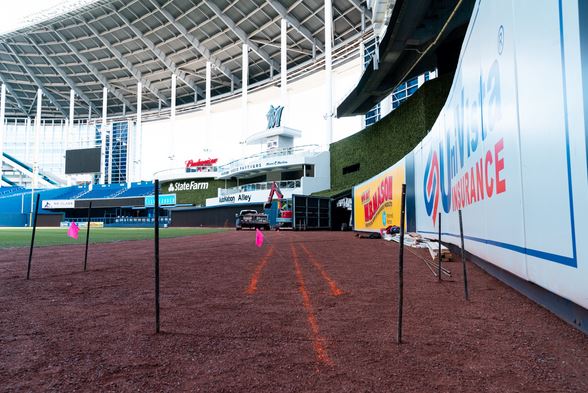Pressure Point: Marlins’ fences a good move; faux turf, we’ll see
Welcome to Pressure Point by Craig Davis, commentary and analysis from a longtime observer and reporter of the South Florida sports scene and its teams.
The Marlins followed this week’s acquisition of two power hitters by announcing alterations to Marlins Park (via the Marlins media blog) that will be conducive to what they do best.
Certainly, newcomers Jesus Aguilar and Jonathan Villar will be pleased to learn the Marlins are moving in the fences 12 feet in center field and right-center. So will returning hitters who have been stymied by vast outfield dimensions that make the Grand Canyon seem cozy.
It remains to be seen how much those same players embrace the other major change to the ballpark that was revealed Wednesday – that the team is installing a synthetic grass surface for next season.
This new Shaw Sports Turf is the same artificial turf as the Arizona Diamondbacks put in Chase Field before last season.
The Marlins are making the switch for the same reason. Like the D’Backs, they have struggled mightily to maintain a natural grass field in the retractable-roof ballpark in Little Havana.
Mixed reviews in ‘Zona
Arizona management is thrilled with the new faux field in Phoenix. Aesthetically, it’s a huge hit.
While D’Backs president/CEO Derrick Hall claims it to be safer and cuts back on injuries, the reviews from players – particularly outfielders – have been mixed. Some have blamed it for back and hamstring problems and report an overall physical toll on their bodies from playing on it regularly.
That raises concern for the Marlins, as the Arizona experience is the only gauge on this particular turf as the first test case. The Texas Rangers’ new ballpark opening in March will also have it.
“Turf is turf; it’s never going to be like real grass and everybody knows that,” Diamondbacks left fielder David Peralta said in an Arizona Republic story about the turf. “We just have to be smart. It can get you pretty good with your hamstring or back and everything.”
Fellow outfielders Adam Jones and Ketel Marte expressed similar views about the effects of playing on it regularly.
No question that the Shaw Sports Turf surface, known as B1K: Batting A Thousand, is much more sophisticated than artificial fields that have been used in the past. Much effort has been put into making it as close to the real thing as possible with current technology.
Arizona players have said they haven’t had a problem with bad bounces, but that the turf does play slower. The latter was supported by data showing a notable decrease in batting average on ground balls hit with an exit velocity of 90 mph or harder, according to Baseball Savant.
“Obviously, I think everybody would rather play on regular grass,” Diamondbacks shortstop Nick Ahmed told the Arizona Republic, while acknowledging the problems the team has had in maintaining live grass.
Some relief for hitters
The Marlins’ experience has mirrored that of Arizona. They’ve used grow lights at night. They have tried at least three different types of turfgrass – two strains of bermudagrass as well as a specialized Paspalum sod. They even tried using one type of grass in the infield and another in the outfield.
Unfortunately, none of it worked satisfactorily.
In the announcement of the switch, Michael Hill, Marlins president of baseball operations said, “While playing the Diamondbacks in Arizona, we were able to get a close look and examine the new surface at Chase Field. We agreed as an organization that this change was for the best after our players and staff had encouraging remarks regarding the playability of the playing surface.”
It will unquestionably be more pleasing to the eye. The field at Marlins Park always lost its luster as the season progressed, especially in the outer reaches of the outfield.
There will be less real estate out there with the fence moving in, and that is a welcome development.
Previous ownership miscalculated in their quest to tailor the ballpark toward pitching when it was built. Instead they created dimensions greatly out of proportion with most of Major League Baseball.
That has been a sore spot with hitters since the park opened, including Giancarlo Stanton, who hated the distant fences and even more so being asked about them.
The size of the outfield got into Christian Yelich’s head. No coincidence that he suddenly became a home run hitter playing in Milwaukee’s more comfy Miller Park.
Fairer dimensions welcome
“As we enhance the playing surface at Marlins Park, we felt it was also appropriate to take the opportunity to evaluate our outfield dimensions,” Marlins CEO Derek Jeter said in the statement. “We made the decision to adjust the distance of the outfield fence, which will now be more in line with the field dimensions you see across many of today’s ballparks.”
This will be the second time the fences have been moved (2016). The change will begin at the end of the digital scoreboard in front of AutoNation Alley in center field and extend to right-center at the start of the visitors’ bullpen.
The distance in straightaway center field will now be 400 feet with the gap in right-center at 387 feet.
It will still be a spacious outfield. And if the artificial turf does play slower it will still skew toward a pitcher’s park.
For a team intent on improving offensive output, bringing in the fences is a good move.
As for giving up on real grass, there is reason to be skeptical about that.



Nice blog for sharing the information about the Fence of the ground.